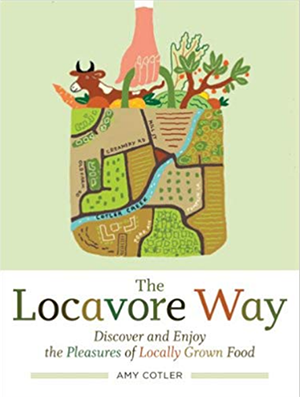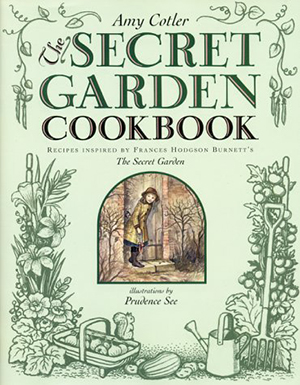
We’re near the Chang Phuak Gate in Chiang Mai, in Northern Thailand. It’s around 6pm, and the bevy of food stands sit behind long tables filled with eating Thai and tourists from all over, mostly China. A woman in a cowboy hat dips into an enormous aluminum pot of rich stock, filled with large bobbing ham hocks. She lifts one out onto a board, then shreds the meat. We chow down on the pork with its deep sauce, along with rice and pickled greens. It was preceded by roasted duck, chopped on a wedge of wood, with bright greens and more rice.
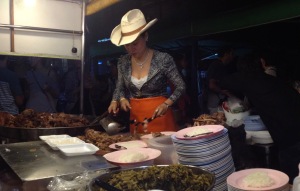
It feels like anarchy around us, but as usual, we just don’t know the system. Order and they find you. Pay afterwards. Only sit at the tables associated with the food vendor, so switch tables when you switch vendors, or so it seems.
On the table sit the pillars of Thai cuisine — always something salty, sweet, sour and spicy. There are endless variations on this, but always the same play of flavors, sweet might be sugar or a sweet red sauce, sour a house made sauce or a few chilies in vinegar, you get the drill. Here the eater is a full participant in their meal, finishing it to taste as they see fit. The Thai do not shrink from powerful flavors.
As we step away from the vendors, heading to our guesthouse, I’m full, I tell myself. But I’m on a roll, an eating machine. And I haven’t had my dessert: sticky rice, the dense rice of the region, permeated with sweet coconut milk, served with fresh mango. Tommy can’t believe I can eat another bite, but I can, I will.
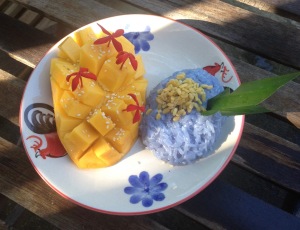
How does one begin to write of Thai food, here in a county more passionate about eating then anywhere I’ve been? Stands of skewered sausage, hot dogs, marinated chicken, stuffed crab and fried chicken fill the air with endless smells. A large cartoon finger of aroma is beckoning me, while I search for the perfect bite. Will it be the herbaceous Northern Thai sausage, fresh from the market?
The best food doesn’t seem to be found in restaurants that hawk too many kinds of foods, from soggy pad Thai to Bratwurst, but in the street stands and smaller places that cook just a few things. Mostly, we look for clean enough joints that specialize in one dish or variations on a theme. At first we went out too late for our meals, but soon got into the rhythm of an early lunch and a right-after-work dinner. I throw out my original concept of looking for iconic dishes, instead hunting down places that have just opened up, or are very busy, using my eyes, my nose.
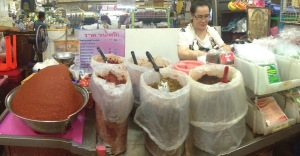
It’s a take-out culture and food abounds. But I don’t always hit it right. So I’m longing to learn the expression, “I’ll have what he’s having,” in Thai. I’ve begun to politely point, if such as a thing is possible. It helps.
I take a few cooking classes. A classmate steers me to a market stand with a mold I’ve seen before, filled with cooking quail eggs. But here, a woman is pouring a rice and coconut batter into the same iron mold. She sprinkles it with Chinese chives or corn. These little cakes, Thai pancakes as they’re called, come out crisp on the outside. Bite them and a sweet warm coconut filling oozes out. I’m hooked.
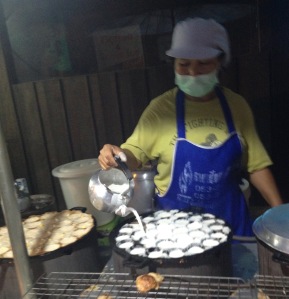
If you thought you knew Thai cooking from eating in Thai restaurants in the States, forget it. My northern Thai master class features recipes like Minced Pork Northern Style (Nam Prik Ong) and Crispy Eggplant Salad (Saa Makua). We eat them thinly sliced and raw. They dance in my mouth. Just one variety of the full spectrum of eggplants available, my favorite, pea-sized and slightly bitter. We chop for hours, then assemble our dishes quickly.
In the classes we pound chili pastes in a large mortar and pestle, as they are the basis of many Thai dishes. These variations on multiple ingredients forming green, yellow, red pastes, remind me a bit of making a Mexican mole, where new and old world foods meet. The whole is more than the sum of its parts in both.
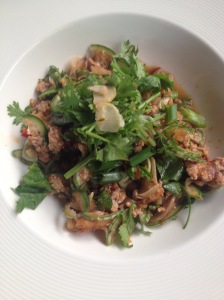
The pastes are made from both fresh and dry ingredients and, like anything made from scratch, they blow away the jarred stuff. The red curry paste, is a combination dried spices and pastes — coriander seeds, cardamom pods, black pepper, dried red chils for color, shrimp paste for depth. The fresh ingredients are fresh ginza, lemongrass, kaffir lime peel, coriander root, shallots, garlic and of course, tiny bird chilies. Add as little or a much heat as you like. (I go for tourist hot, not Thai hot.) Sometimes the pastes are fried with meat, sometimes they’re dropped into liquid.
The more elementary class at the Thai Farm Cooking School is a full day, a lovely excusion for those new to Thai cooking. And visitors can see lemon grass, tamarind, galangal (ginza), kaffir lime (and the fragrant leaves) growing, giving context to the food. Worth going.
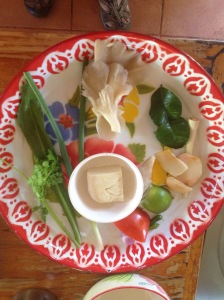
Both classes include a trip to the market, where we saw coconut cream produced. The young coconut has sweet water, we’ve all be buying lately at home. But the older coconuts make cream. Crack them open, shred them, squeeze them for cream, dilute them with 50% water for milk. The merchant has a large professional grinding tool. But I’ve seen hand held graters used. And at the Chiang Mai Cookery School, the teacher’s grandmother’s tool sat atop a knee wall. It was chunk of wood to straddle, one leg on either side, with a perfectly shaped grater attached. Bend over, grate.
Northern food is different from any Thai food I’ve eaten, but Chiang Mai is a sophisticated city, serving food from all over Thailand. This is a forested, mountainous region. Sticky rice is traditionally the staple food. It’s dense, and yes sticky, meant to be eaten with your hands. Although most Thais I see use forks and spoons, except for noodles, when chopsticks are essential. We’ve seen lots of brothy food and minced meat salads. At a bustling restaurant where I was told the cabbies eat, I received a bowl full of what looked like blood-colored tofu. But it was cubes of chicken blood. Go figure: The Asian range of edibles is far broader than ours.
At the Chiang Mai Cookery School the teacher took us on a tour of their garden, mostly of his pen of wild boars. Clinging to the back garden wall was a huge hive of bees, which he told us to walk around quietly. One or two, maybe even three stings and you survive, he told us. Although you are scarred for life, he added. Seven or more stings, and it is kinder to be shot by your friends. He motioned a holding up a rifle and firing. Nevertheless, this kind of bee hive is considered good luck. The hive is collected at night, while the bees sleep. You bore a hole into it, cover it with plastic, then smoke the bees out. They flee, leaving their eggs behind. Delicious eggs, he tells us.

There is fresh juice, fresh fruit is everywhere. Mangos, pineapple slices on sticks. Durian fruit gives literal meaning to the phrase forbidden fruit, after I spotted a sign with its picture in a circle with a slash through it. Banned from the hotel, its smell is a pungent mixture of sweet fermenting garbage and old socks. Tommy bought a tiny piece and liked it, smiling, “a little goes a long way.” But I’m waiting to return to Bangkok to uphold my try-everything pledge. (more below)
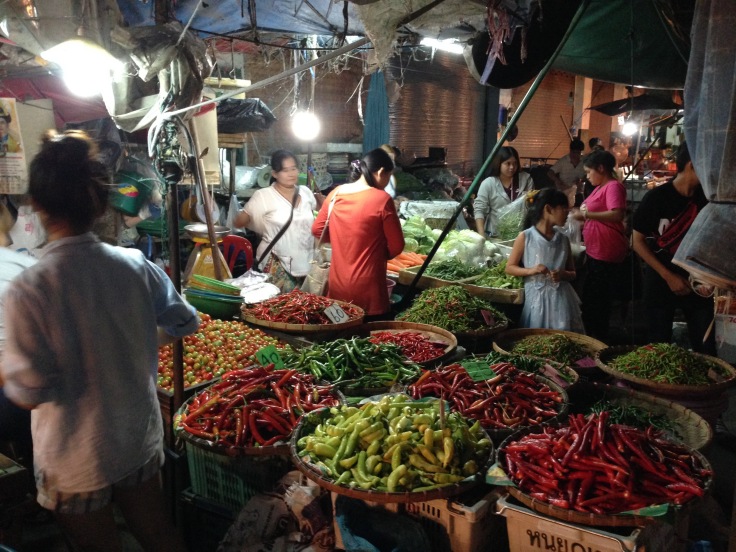
Markets are everywhere, including the giant night market. The streets are closed and lined with stalls for the Saturday and the Sunday walking markets. Blind musicians play Thai music. We stand still with the crowd a 6:00 pm for a tribute to the king.
But for me, the real Thailand can be seen in the food markets I fall upon in unknown alleys, and the fabulous Warorot Market (Kad Luang) right next to the orchid filled flower market. Dedicated to food alone, it’s packed with fresh and prepared foods of all kinds — the go-to place for shopping Thais. I went alone and early, watching it fill to bursting. I stumbled around dazed by the array of foods — triangles of banana leaves filled with sweet bean curd, bamboo wrapped sticky rice, already cooked, ready for the grill.
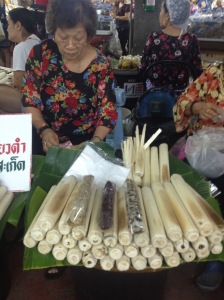
Pickled vegetables, dried fruit. At least six varieties of fresh mushrooms line up in their neat plastic bags, readied for sale. Customers crowded round the sausage maker, filling bags with warm coils to go. No iPhone 4 pictures could convey the excitement this food freak felt in this market. Go!

One night we went upscale, dining in the candle lit Ruan Tamarind Restaurant, next to a glittering pool and slow slung Thai building. We started with a crab spring roll, more celery than crab. Then we savored sweet ribs and Yum Tawai Gai, a classic Thai dish. It’s not a salad as we know it, but a complex toss of vegetables, morning glory and basil leaves, tossed in a tamarind coconut milk dressing, topped with the commonly used fried shallots and garlic, as well as peanuts and chicken.
Another night we stopped by SP Chicken, bustling with tables filled with eating and laughter. We devoured a small but succulent rotisserie chicken stuffed with garlic and accompanied with powerful sauces. Then we share my beloved morning glory greens with, guess what, more garlic.
But then, when I’m starting to get the hang of it, it’s time to move on….


